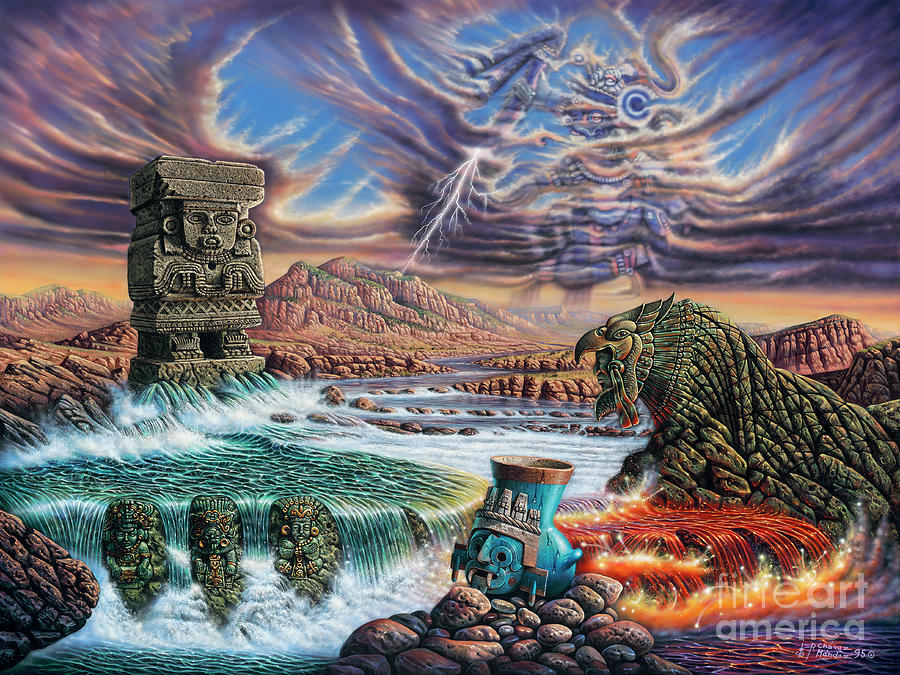
Thundering Gods

by Ricardo Chavez-Mendez
Original - Not For Sale
Price
Not Specified
Dimensions
36.000 x 48.000 x 1.500 inches
This piece is not for sale. Please feel free to contact the artist directly regarding this or other pieces.
Click here to contact the artist.
Title
Thundering Gods
Artist
Ricardo Chavez-Mendez
Medium
Painting - Acrylic On Canvas
Description
The origins of the rich and colorful Mexican culture date back to various centuries before Christ. Since these cultures are too numerous to mention, this painting depicts the last era of pre-Hispanic Mexico, before the Spanish conquest. The Aztecs worshiped at least 1,600 gods in which many were adopted from the powerful TOLTEC civilization. The water gods, TLALOC and CHALCHIUHTLICUE (chal-chee-oo-tlee-quay) are the focus in this painting since water plays a major role in all of Ricardo's surrealistic artwork. The origins of these two gods date back to the TEOTIHUACAN (tay-oh-tee-wha-can) culture. The city of TEOTIHUACAN was considered one of the greatest cities for religion, politics, and mercantilism of the ancient world.
As in all of Ricardo's surreal work, the number's three and seven are prominent and in this painting, seven focal points are symbolically represented. TLALOC, the god of rain and agriculture (depicted in the clouds) was a very powerful god, along with the god of war. He took on many manifestations and relished the sacrifice of children. CHALCHIUTLICUE, the goddess of water from springs, seas, rivers and lakes (monolith to the left of TLALOC), was known as the jade-skirted lady. She was the consort of TLALOC. The blue vase in the foreground of the painting is another manifestation of TLALOC. Here Ricardo portrays two ways the Aztecs worshiped him with the vase being the dividing line. The first one is miccatzintli - the state of death. When someone in the Aztec community died by drowning or any illness related to water, they would paint their faces blue (that is why the color of the vase is blue) and bury them in the river (symbolized by the three jade figures in the water). At the moment of burial, a dry branch was placed on their chest so that upon arriving in paradise, the dry branch would bloom. The other way was more violent. Wars, prisoners, and human sacrifice were necessary for the Aztecs. For example, in the capital city, at the dedication of the great temple in México-Tenochtitlán (MEH-hee-coh tenosh-tee-TLAN), captives were sacrificed. The chiefs and priests would take turns cutting out beating hearts and burn them in braseros or brazen pots (symbolized by the red, lava-like water) to appease the gods. A man's life was the ultimate sacrifice, therefore, the Aztecs referred to the sacrificial victims as eagle warriors (represented by the sphinx-like rock structure) for once they spilled their flowery blood to feed the gods, they ascended into the heavenly company of the sun. It is said that the priests would pray for the eagle warriors asking that they would "savor the sweet fragrance of death by the obsidian blade." That is why the vase is crying.
This all takes place in a southwest landscape for history tells us that the TOLTEC culture influenced both coasts of the Pacific and Gulf of Mexico, as far up as the Mississippi Valley (in the United States) and as far down as the Yucatán peninsula. The Aztecs spoke the NAHUAN or NAHUATL (NAH-wahtl) language, which relates to the languages of the Piman and Shoshonean tribes of the western United States for they say the Aztecs came from the North.
Water was very important to the Aztec civilization because their basis of existence was agriculture. In this painting the water represents many things (green=jade skirt of CHALCHIUHTLICUE; white=foam from the rapids; red=diet of human hearts and blood) but symbolically, it represents the Mexican flag (green, white & red). In their long search for a home, the Aztecs were guided by the hummingbird god, HUITZILOPOCHTLI (weets-ee-loh-POCHE-tlee) who also gave them a new identity as well, by telling them "Your name will no longer be AZTECA. You are MEXICA (meh-SHEE-kah). Go and look at the cactus and on it you shall see an eagle eating a snake and warming itself in the sun." This appears on the flag today as the symbol of the astounding TENOCHTITLAN. The name MEXICA would mystify scholars and eventually identify a great modern nation called MEXICO.
Licensing available. Please contact ORO Fine Art Gallery directly by email.
Uploaded
November 25th, 2018
Statistics
Viewed 5,490 Times - Last Visitor from Fairfield, CT on 04/25/2024 at 1:13 AM
Embed
Share
Sales Sheet
Comments
There are no comments for Thundering Gods. Click here to post the first comment.






















































